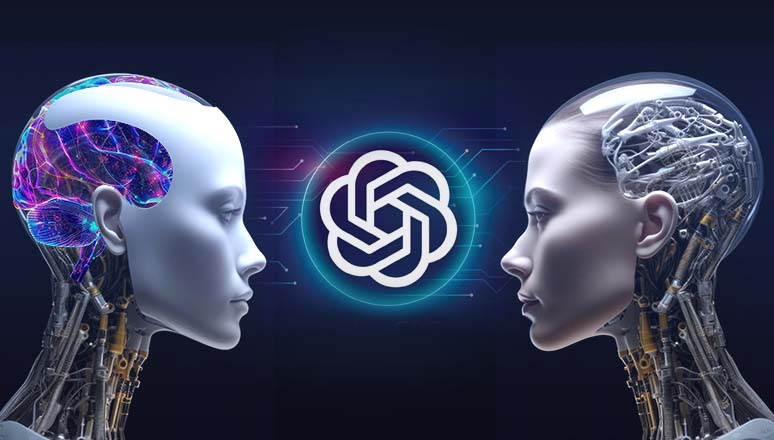The world of Artificial Intelligence (AI) is expanding fast, but with that growth comes confusion. Terms like ChatGPT, Generative Artificial Intelligence (also known as Generative AI), and Predictive Artificial Intelligence (Predictive AI) are often used interchangeably, even though they serve distinct purposes.
Let us explore what sets them apart, how they work together, and where you will encounter them in real-world applications.
What Is Generative Artificial Intelligence (Generative AI)?
Generative AI refers to systems that create content – whether it is text, images, audio, video, or even software code – by learning patterns from existing data.
Popular tools: DALL·E, Midjourney, GitHub Copilot, and of course, ChatGPT.
How it works: These systems use deep learning techniques to predict and generate the next part of a sequence – be it the next word in a sentence, a brush stroke in an image, or a line of code in a script.
Use cases:
- Writing blog posts, emails, reports
- Designing marketing assets or user interfaces
- Auto-generating code or SQL queries
- Creating training data or test scenarios
Generative AI is the creative brain of the AI family – it helps you make something out of (almost) nothing.
What Is ChatGPT?
ChatGPT is a conversational interface built on a Generative Pre-trained Transformer (GPT) model developed by OpenAI.
It is a specific implementation of Generative AI focused entirely on generating human-like text responses in the context of dialogue.
Why it stands out: Unlike many generative systems, ChatGPT is optimized for conversation. It can track context across multiple turns, mimic tone, and provide helpful or creative responses based on the prompt.
Use cases:
- Virtual assistants and chatbots
- Customer support automation
- Brainstorming and idea generation
- Summarizing long documents or meetings
Think of ChatGPT as your AI-powered teammate who happens to be really good at explaining things, writing fast, and never gets tired of brainstorming.
What Is Predictive Artificial Intelligence (Predictive AI)?
Predictive AI is all about foresight. Rather than creating something new, it analyzes past data to make educated guesses about future events.
Popular tools: Netflix recommendations, fraud detection systems, sales forecasting platforms, and credit scoring models.
How it works: Predictive AI uses machine learning models trained on historical datasets to recognize patterns, classify risks, or forecast trends.
Use cases:
- Recommending content or products to users
- Predicting equipment failure in manufacturing
- Anticipating customer churn in subscription services
- Forecasting stock levels or demand in retail
Where Generative AI is about creativity, Predictive AI is about strategy. It helps teams anticipate what is likely to happen next.
Comparing ChatGPT, Generative AI, and Predictive AI
| Feature |
ChatGPT |
Generative AI |
Predictive AI |
| Primary Goal |
Human-like conversation |
Creative content generation |
Forecasting future outcomes |
| Uses AI Model |
GPT (Generative Pre-trained Transformer) |
Various large generative models |
Regression, decision trees, neural nets |
| Common Use Cases |
Chatbots, assistants, support |
Art, writing, code, music |
Risk scoring, recommendations, forecasts |
| Interaction Type |
Dialogue-based |
One-shot or iterative creation |
Backend analytics and insights |
| Human Involvement |
High (interactive) |
Medium (collaborative creation) |
Low (automated suggestions) |
Why This Matters for Your Business
Understanding these distinctions is not just academic – it is strategic. Whether you are building smarter workflows, enhancing customer experience, or future-proofing your operations, knowing which AI to deploy (and when) can be a game-changer.
Planning a marketing campaign?
Use Generative AI to write the content.
Use Predictive AI to identify which audience segments are most likely to convert.
Use ChatGPT to simulate customer reactions or generate variations in tone.
Building a support tool?
Use ChatGPT to power the live interaction.
Use Predictive AI to flag likely problem areas based on ticket history.
Use Generative AI to suggest pre-written responses or documentation.
Managing a logistics operation?
Use Predictive AI to forecast delivery delays or demand spikes.
Use Generative AI to generate daily reports or communications.
Use ChatGPT as a natural-language interface for operators to ask questions like “What’s the status of Truck number **?”
The magic often happens when these systems are combined. Generative AI can create the message. Predictive AI can decide who should get it when. ChatGPT can deliver it through a natural, human interaction.
Final Thoughts: Don’t Choose, Combine
In a world where speed, personalization, and automation matter more than ever, understanding the nuances between these types of AI can give your team a competitive edge.
Rather than asking, “Which one should we use?”- the better question might be:
“How can we combine ChatGPT, Generative AI, and Predictive AI to solve our problems faster, smarter, and more creatively?”
The future of AI is not about competition between tools – it is about orchestration.



